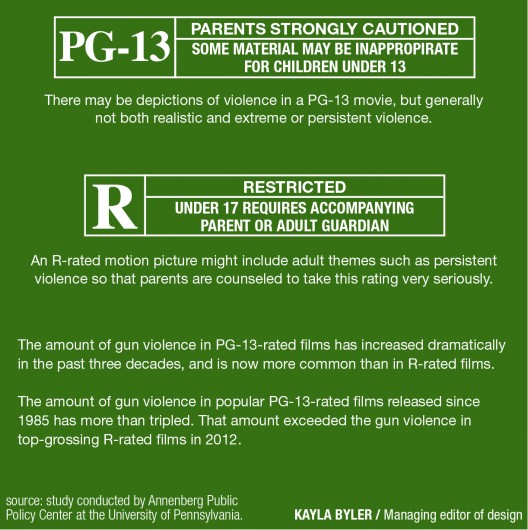Ohio State students taking a trip to the movies might be surprised to learn that the PG-13-rated option likely has more gun violence than the R, according to a recent study.
A study released by a team of researchers that included an Ohio State professor found the amount of gun violence in PG-13-rated films has increased dramatically in the past three decades, and is now more common than in R-rated films.
Brad Bushman of OSU’s School of Communication contributed to the study “Gun Violence Trends in Movies,” which was published recently in partnership with the Annenberg Public Policy Center at the University of Pennsylvania.
The study concluded the amount of gun violence in popular PG-13-rated films released since 1985, the first full year of the PG-13 rating, has more than tripled. That amount exceeded the gun violence in top-grossing R-rated films in 2012.
The study also found that the overall rate of violence in the highest grossing movies has more than doubled since 1950.
Bushman became involved in the study after publishing a paper on the weapons effect, which claims the presence of weapons might be enough to lead to an increase in aggressive behaviors in a person.
“We wanted to find out if films today contained more weapons,” Bushman said.
Because of the increasing popularity of PG-13 films aimed at younger viewers, these viewers are exposed to more violence in the film’s scripts, according to the study.
“Gun Violence Trends in Movies” looked at 945 films released between 1950 and 2012 drawn from the top-30 highest grossing films of each year, and then half of those top 30 movies were selected at random.
Of the PG-13-rated films from this list, 94 percent of the films were found to contain one or more five-minute segments involving a violent sequence.
Gun violence was classified as the firing of handheld guns with the intent to kill or harm a living being, excluding acts such as hunting, accidents and the use of large-scale weaponry such as rocket-propelled grenades, according to the study.
There can be “depictions of violence in a PG-13 movie, but generally not both realistic and extreme or persistent violence,” according to the Motion Picture Association of America, which rates U.S. movies.
Bushman said unrealistic violence might not make a difference to the audience viewing the movie, but audience members’ perceptions of violent acts might be impaired after being exposed to it many times.
“Violent media can increase aggression and make people numb to the pain and suffering of others,” he said.
Other researchers in the study saw the results as harmful for the younger viewers who are the target audience for PG-13-rated films.
“It’s disturbing that PG-13 movies are filled with so much gun violence,” said Dan Romer, one of the researchers and director of the adolescent communication institute of the APPC, in a released statement. “We know that movies teach children how adults behave, and they make gun use appear exciting and attractive.”
Awareness of violence in mainstream films has increased, especially after various recent violent events. A shooter who opened fire at an Aurora, Colo., theater killed 12 people July 20, 2012, at the midnight premiere of “The Dark Knight Rises.” The movie was a major PG-13-rated film that contained multiple scenes of intense gun violence, but made more than $1 billion at the worldwide box office.
Some OSU students who are frequent moviegoers said gun violence is more acceptable to audiences today.
Evelyn Luther, a second-year in arts and technology, said film violence is generally less controversial than strong language or nudity.
“If you look at movies that were rated PG-13 10 years ago, even if you look at the R-rated movies, they’re not as violent as PG-13 movies nowadays,” she said.
She said it’s because of a misplaced sense of political correctness.
“America is totally cool with as much violence as possible,” Luther said. “But God forbid you should say the F-word.”
Hareesh Menon, a first-year in physics, said the amount of violence in movies might decrease.
“There will still be a lot of gun violence, but I don’t think (filmmakers) will have more graphic gun violence in the future,” Menon said.
Garrett Merz, a second-year in physics, said while PG-13 gun violence is seen as less realistic, it still might have negative impacts on its audience.
“Gun violence in particular can almost trivialize violence in a sense, because it might not necessarily be more graphic but it’s more throwaway violence than in R-rated movies where you might get some of the more explicit things,” he said.
Merz compared gun violence in a PG-13 film to using a Nerf gun, in which shooting others is seemingly only part of a game.
Other students, though, did not see as much of a problem with the increase of gun violence in movies.
Lucas Beaufore, a second-year in physics, said a PG-13 rating isn’t meant to be the deciding factor in whether or not children can watch a movie.
“Generally the ratings are meant for the parents to be able to decide what their children watch, not to be the ultimate decider,” Beaufore said.
Bushman said in the future, the ratings of films with gun violence has to be changed.
“The trends from the study suggests that the increase (of gun violence in PG-13 films) will continue,” he said. “I would like to see films containing gun violence rated R.”



